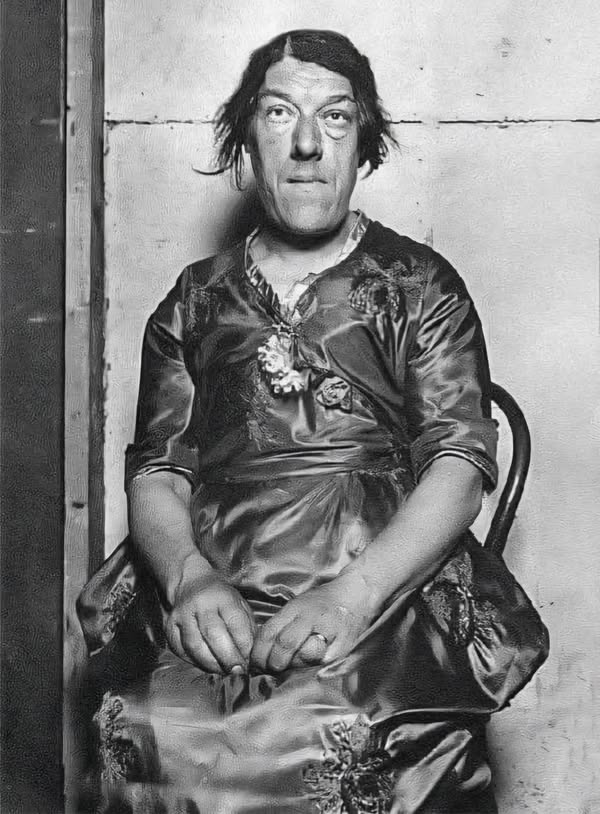We’ve come a long way as a society. While we still have work to do, many of the cruelties once accepted as entertainment now feel unthinkable. One of the most shocking examples? The 19th-century freak shows—traveling spectacles that exploited people with visible differences for profit and amusement.
Among the many tragic figures from that era, Mary Ann Bevan stands out—not because of her appearance, but because of her strength, sacrifice, and the heartbreaking choices she had to make for her family.
A Promising Start
Mary Ann was born Mary Ann Webster on December 20, 1874, in Plaistow, East London, one of eight siblings in a working-class family. While her brothers were sent off to work, Mary Ann pursued education and, in 1894, proudly became a nurse—a respected and rare career path for women at the time.
She was a striking young woman with soft features and a bright future. In 1902, she married Thomas Bevan, and together they had four children, building what seemed like a happy, stable life.
But fate had other plans.
The First Signs of Change
Shortly after her marriage, Mary Ann began to notice changes in her body—subtle at first, then increasingly impossible to ignore. Around the age of 32, she developed symptoms of acromegaly, a rare hormonal disorder caused by excess growth hormone. It affects soft tissue and bone, often enlarging the hands, feet, and especially the facial structure.
At the time, acromegaly was not well understood, and treatments were nearly non-existent. As her features became more masculine and her appearance drastically changed, Mary Ann endured not just physical suffering but also social alienation and growing insecurity.
Then tragedy struck again: Thomas died suddenly of a stroke after 14 years of marriage. Mary Ann was left a widow with four children to care for—and a body that the world had begun to treat with cruelty.
A Desperate Decision
As her appearance changed, Mary Ann faced increasing discrimination. No one would hire her. Even her past experience as a nurse couldn’t overcome the prejudice she encountered. With bills piling up and her children depending on her, she was running out of options.
Then, one day, she saw an ad in the newspaper:
“Wanted: Ugliest woman. Nothing repulsive, maimed or disfigured. Good pay guaranteed, and long engagement for successful applicant. Send recent photograph.”
The ad was from Claude Bartram, an agent for Barnum & Bailey, one of the biggest circus operators in the world. And though the premise was heartbreaking, Mary Ann applied—not out of vanity or ambition, but out of pure necessity.
“She told me she did not like the idea of placing herself on exhibition,” Bartram later said, “but she was shy and did not want to be separated from her children… She wanted to provide for their education.”
Life in the Spotlight
Mary Ann was hired and became known as the “Ugliest Woman in the World.” Her image was splashed across newspaper covers when she arrived in New York in 1920 to perform at Coney Island’s Dreamland Circus.
She wore men’s clothes and exaggerated makeup to appear even more “shocking.” She was laughed at, mocked, and treated as a curiosity. But she endured it all—for her kids.
Though exploited, she made good money—enough to send her children to boarding school in England. By some reports, she earned the equivalent of nearly $590,000 in today’s money through her work and the sale of picture postcards featuring her image.
One of the few who publicly defended her was renowned neurosurgeon Dr. Harvey Cushing, who wrote to Time Magazine condemning the sideshow’s treatment of Mary Ann:
“She… has become the victim of a disease known as acromegaly. This is far from mirth-provoking.”
A Mother’s Sacrifice
Despite the shame and the ridicule she endured, Mary Ann never wavered in her role as a mother. She sacrificed her dignity, her comfort, and even time with her children—who remained in England—just to make sure they had a chance at a better life.
She worked with the circus until the end of her life, only briefly leaving in 1925 to participate in an exhibition in Paris. She passed away in 1933 at age 59, and her children honored her final wish: to be buried in her hometown. Today, she rests in Ladywell and Brockley Cemetery in South London.
A Legacy of Strength
It’s easy to look back and judge the era that turned people’s pain into entertainment. But Mary Ann Bevan’s story reminds us that, behind the headlines and the cruelty, there was a woman—a mother—who did whatever it took to care for her children.
She didn’t seek fame or pity. She sought survival, and in doing so, showed the world what real strength and love look like.
So while she may have been branded with one of the most dehumanizing titles in history, we know better now. Mary Ann Bevan was not the “ugliest woman”—she was one of the bravest.
Rest in peace, Mary Ann. Your beauty was never in question.

Sophia Reynolds is a dedicated journalist and a key contributor to Storyoftheday24.com. With a passion for uncovering compelling stories, Sophia Reynolds delivers insightful, well-researched news across various categories. Known for breaking down complex topics into engaging and accessible content, Sophia Reynolds has built a reputation for accuracy and reliability. With years of experience in the media industry, Sophia Reynolds remains committed to providing readers with timely and trustworthy news, making them a respected voice in modern journalism.


